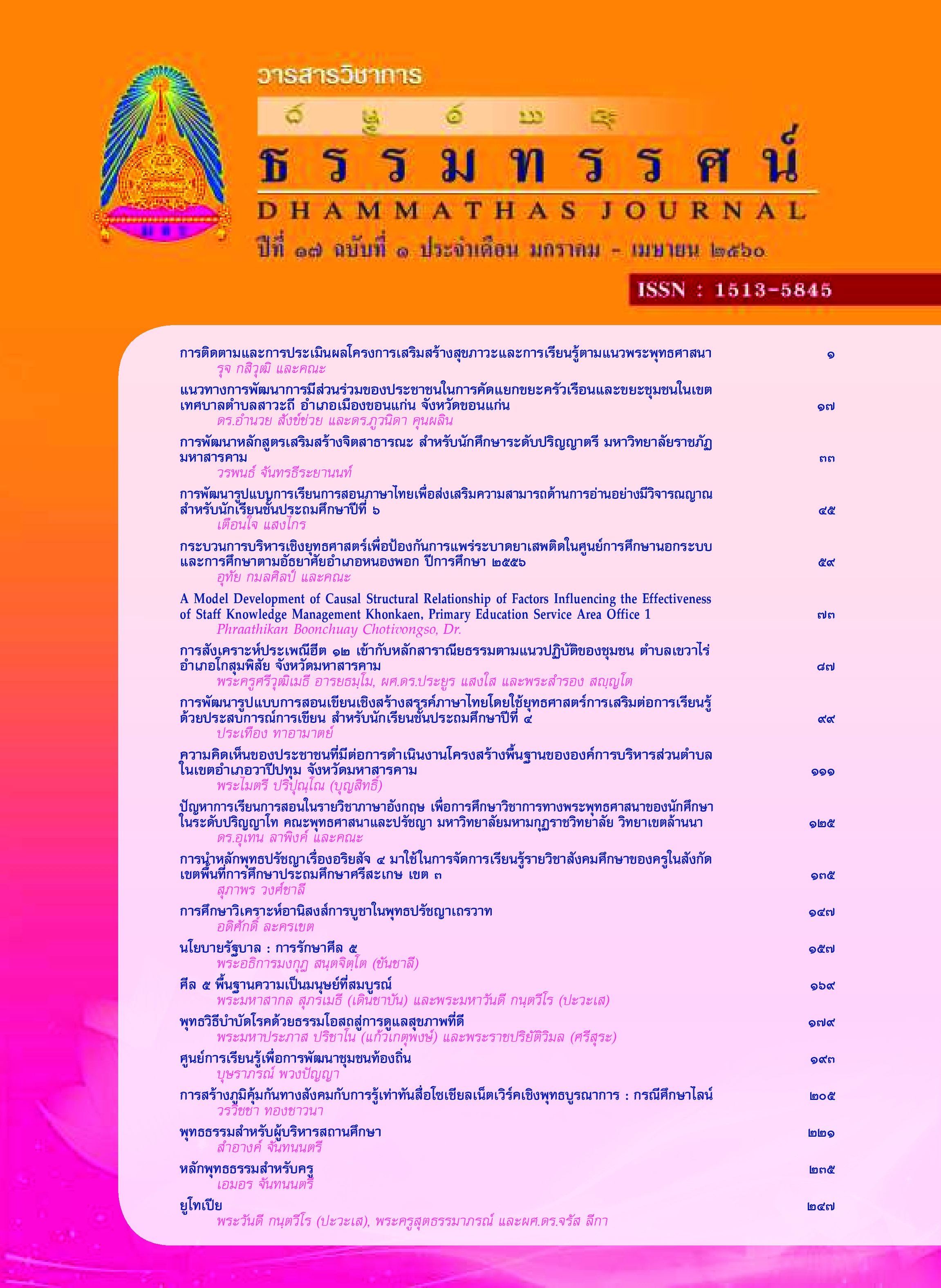การพัฒนาหลักสูตรเสริมสร้างจิตสาธารณะ สำหรับนักศึกษาระดับปริญญาตรี มหาวิทยาลัยราชภัฏมหาสารคาม
Main Article Content
Abstract
บทคัดย่อ
การวิจัยครั้งนี้มีวัตถุประสงค์เพื่อพัฒนาหลักสูตรเสริมสร้างจิตสาธารณะสำหรับนักศึกษาระดับปริญญาตรี มหาวิทยาลัยราชภัฏมหาสารคาม การวิจัยเป็นการวิจัยแบบผสานวิธี กลุ่มเป้าหมายที่ใช้ในการวิจัย คือ นักศึกษาระดับปริญญาตรีภาคปกติ ชั้นปีที่ ๒ คณะมนุษย์ศาสตร์และสังคมศาสตร์ ปีการศึกษา ๒๕๕๗ มหาวิทยาลัยราชภัฎมหาสารคาม
ผลการวิจัยพบว่า
๑. ผลการพัฒนาหลักสูตรเสริมสร้างจิตสาธารณะสำหรับนักศึกษาระดับปริญญาตรี มหาวิทยาลัยราชภัฏมหาสารคาม ๑.๑ การศึกษาและวิเคราะห์ข้อมูลพื้นฐาน ผลการศึกษาพบว่า จิตสาธารณะ เป็นคุณลักษณะสำคัญและจำเป็นต้องเสริมสร้างให้แก่นักศึกษา ตามองค์ประกอบของการมีจิตสาธารณะ ทั้ง ๓ ด้าน ได้แก่ ด้านการรู้คิด (Cognition) ด้านเจตคติ (Attitude) และด้านพฤติกรรม (Behavior)
๑.๒ การสร้างหลักสูตร เป็นการนำผลการศึกษาที่ได้จากขั้นตอนที่ ๑ มากำหนดเป็นรายละเอียดต่างๆ ของหลักสูตรฉบับร่าง ผลประเมินความเหมาะสม และความสอดคล้องของหลักสูตรหลักร่างโดยผู้เชี่ยวชาญ พบว่า ทุกองค์ประกอบของหลักสูตร เหมาะสมและสอดคล้องกับการเสริมสร้างจิตสาธารณะให้แก่นิสิต จากนั้นนำข้อเสนอแนะจากการประเมินหลักสูตรฉบับร่างมาปรับปรุง เพื่อให้หลักสูตรมีความเหมาะสมยิ่งขึ้น
๒. ผลการศึกษาประสิทธิผลของการพัฒนาหลักสูตรเสริมสร้างจิตสาธารณะสำหรับนักศึกษาระดับปริญญาตรี มหาวิทยาลัยราชภัฏมหาสารคาม
๒.๑ การทดลองใช้หลักสูตร เพื่อตรวจสอบประสิทธิผลของหลักสูตร ผลการวิจัยพบว่า ระดับจิตสาธารณะของนักศึกษากลุ่มเป้าหมายก่อนการทดลอง และหลังการทดลองใช้หลักสูตรแตกต่างกันอย่างมีนัยสำคัญทางสถิติที่ระดับ .๐๐๑
๒.๒ การประเมิน แก้ไข และปรับปรุงหลักสูตร พบว่า ทุกองค์ประกอบของหลักสูตรมีความเหมาะสม
๒.๓ โมเดลปัจจัยที่มีอิทธิพลต่อจิตสาธารณะสำหรับนักศึกษาระดับปริญญาตรี มหาวิทยาลัยราชภัฏมหาสารคามมีความสอดคล้องกับข้อมูลเชิงประจักษ์ (x2 = ๕๓.๖๑, df = ๕๘, p = ๐.๖๓๙) ดัชนีวัดระดับความกลมกลืน (GFI) เท่ากับ ๐.๙๙๕ ดัชนีความคลาดเคลื่อนในการประมาณค่าพารามิเตอร์ (RMSEA) เท่ากับ ๐.๐๐๐
๒.๔ ปัจจัยที่มีอิทธิพลต่อจิตสาธารณะสำหรับนักศึกษาระดับปริญญาตรี มหาวิทยาลัยราชภัฏมหาสารคาม ปัจจัยที่มีอิทธิพลทางตรงคือด้านการคิดปัจจัยที่มีอิทธิพลทั้งทางตรงและทางอ้อมคือ ด้านพฤติกรรม ด้านอื่นๆ (การอบรมเลี้ยงดู) และปัจจัยที่มีอิทธิพลทางอ้อมคือด้านเจตคติ
Abstract
The research aimed to develop a public mind enhancement curriculum for undergraduate students of Rajabhat MahaSarakham University and study the effectiveness of the development of the public mind enhancement curriculum for undergraduate students of Rajabhat MahaSarakham University. The research was Mixed Method. The sample was regular undergraduate students of the Faculty of Humanities and Social Sciences of Rajabhat MahaSarakham University in the academic year 2014 with 30 2nd year.
The results are concluded as follows:
1. The results of the development of the public mind enhancement curriculum for undergraduate students of Rajabhat MahaSarakham University:
1.1 The study and analysis of the baseline data: this step was collection of data from related documents and researches, interviewing concerned individuals, students’ focus group, and service club members’ focus group. The results reveled that public mind is an important characteristic and is needed to be enhanced in the minds of students, with all the 3 components of public mind: cognition, attitude, and behavior.
1.2 Curriculum construction: this was carried out by putting the results of the study in step 1 into details in the draft curriculum, comprising basic concepts, rationale, curriculum objectives, curriculum structure, learning experience organization, and measurement and evaluation of the curriculum developed. The content structure consisted of 4 learning units, with 8 activities. The learning experiences were organized according to the 4 steps of public mind development: perceiving, responding, seeing the value, and organizing the system and building the habit. The length of time used was 40 hours. The results of the suitability and congruence evaluation of the draft curriculum by experts revealed that every component of the curriculum was suitable and congruent with public mind enhancement for the students. Then suggestions collected from the evaluation of the draft curriculum were used in the improvement of the curriculum.
2. The results of the study of the effectiveness of the development of the public mind enhancement curriculum for undergraduate students of Rajabhat MahaSarakham University.
2.1 The curriculum tryout: the curriculum tryout was method out to examine the effectiveness of the curriculum. The research was the one group quasi-experimental design with one-group pretest-posttest design with 30 2nd year regular undergraduate students of the Faculty of Humanities and Social Sciences of Rajabhat MahaSarakham University in the academic year 2014, obtained through application and selection of those who had the qualification as specified. The results revealed that the level of public mind of the target group before and after the curriculum tryout differed with statistical significance at the level of .001. The results of doing the practical public mind project passed the criteria in every step. In addition, the students were satisfied with the curriculum in the high level.
2.2 Curriculum assessment, correction and improvement: from the results of the curriculum tryout, it was found that every component of the curriculum was suitable. However, after the developed curriculum tryout, there was an improvement of the developed curriculum by extending the length of time for activities, improving the language used, and improving the learning organization plans as to make them continuous. Then the complete version of the public mind enhancement curriculum for undergraduate students of Rajabhat MahaSarakham University curriculum was constructed.
2.3 The model of factors influencing the public mind of the undergraduate students of Rajabhat MahaSarakham University was consistent with the empirical data (x2 = 53.61, df =58, p = 0.639), the Goodness of Fit Index (GFI) was 0.995, the Root Mean Square Error of Approximation was 0.000.
2.4 The factor having direct influence on the public mind of the undergraduate students of Rajabhat MahaSarakham University was cognition. The factor having both direct and indirect influence was behavior. Others (rearing) and the factor having indirect influence was attitude.

